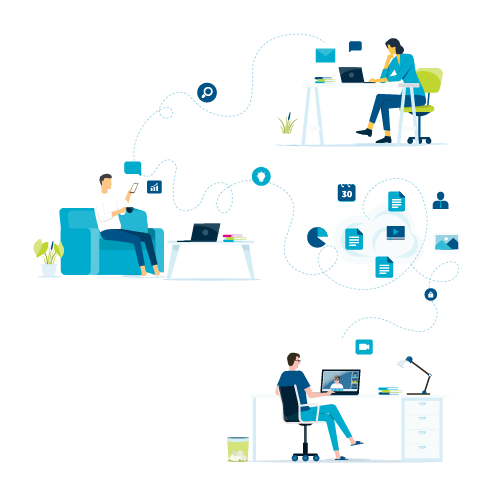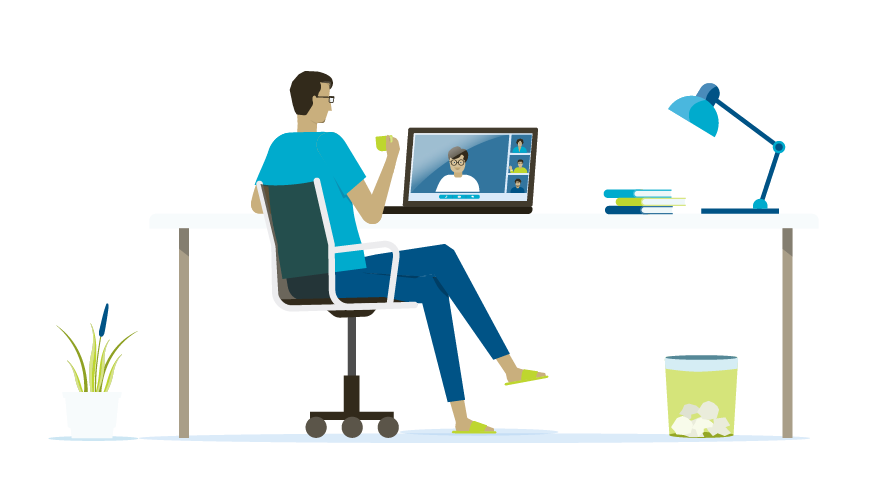The resilience of businesses and adaptability of employees have certainly been put to the test with recent changes to working life. The unprecedented pandemic has undoubtedly brought with it insecurity and turmoil, but there’s also been some amazing teamwork, strength and resourcefulness showcased across all industries.
Adjusting to the ‘new normal’, or perhaps the ‘next normal’ for those who are still in that dreaded period of change is not an easy feat, especially when the desk in your spare room (or bedroom) is the one you’re starting a brand-new job at. But you may be pleased and slightly relieved to hear that 77% of people find working from home to be much better for their overall health and wellbeing, and don’t get us started on their productivity – you’ll soon see it’s not all doom and gloom.
Beginning a new role can certainly be daunting, but doing it remotely unquestionably adds another level of complexity to the challenge for yourself and your employer. Allow yourself to have a moment of panic about your virtual onboarding, but remember…
Be Proud! Congratulations on your new position! You are beginning this role in vastly uncertain times and in a very unusual setting. The brilliant thing is that you’re being proactive and looking for tips on how to make it a positive experience – otherwise you wouldn’t be here reading this blog! Employers and HR, if you’re here for tips then have no fear as we’ve got plenty coming your way; both for your reference and to help you understand the anxieties which may be concerning your potentially new members of staff.
That’s where we come in! Whether you’re an employer looking to virtually onboard your newest member of staff, or a new starter anxious about joining your team on Monday, we’ve got all the tricks in the book from HR and Technology to Interns and Managers.So, let’s get cracking on your remote journey, and making virtual onboarding your forte!
Firstly, it’s not all that different from being in the office
Comparing first day virtual introductions to in-person meet-and-greets, bar some uncomfortable shoes and a grand tour of the office, things really aren’t all that different!
It’s a breath of fresh air for many to discover that the structure of beginning a new role remains more or less the same. The vast majority of businesses now have the infrastructure in place to facilitate remote working, which means you’ll (hopefully) be looked after just as well as you would be in the office.
Expect your first week to be filled with introductions to the team via the likes of Microsoft Teams, Zoom or Google Meet video calls and forgive yourself for forgetting everyone’s name almost immediately (you would have in the office anyway!). Most companies will have an organisational structure which you can explore to make sure you’re liaising with the correct department.
Choose your new workspace
Something which you might not have considered when remotely preparing for your new role is your workspace. It’s really important to determine your needs before deciding where the best location is for you to work, and also what equipment you may need to begin your remote role successfully.
Do you work best in a light, bright room? Are you working with audio which means you’ll need minimal sound? Not everyone working remotely will be using their desk all day, so consider what works best for you.

Space is often a limiting factor when working from home, especially when family members or flatmates are working there too. The key is to do what you can to establish your own workspace outside of the place you spend your evenings and weekends (for many, this means avoiding sitting in bed on your laptop!). Instead, try the dining room table, or if space is limited consider taking advantage of portable desks, like the ones available here.
A note to employers: you should strive to have equipment delivered to your new employees’ home ahead of time, checking if they need any special equipment which may not be in your standard remote setup, such as ergonomically designed chairs or hands-free devices. It’s also vital to consider how secure your employees’ remote workspaces are – Willis Towers Watson recently published an article detailing the importance of cyber risk management within remote workspaces, read more on the discussion here. Adapting to virtual onboarding quickly means you can confidently guide your team and advise best practices for cyber secure workplaces.
Find your work buddies

One thing which really stood out to most people we spoke to was how beneficial it was to have a “buddy” who they could quiz with any work-related questions – so employers, if you’re reading this and your workplace doesn’t have a similar system in place, it’s definitely worth considering introducing it.
In the office, people benefit from asking their teammates across the way questions about the project they’re working on, how to use new software and more – but with remote working, most don’t have that luxury. Don’t be afraid to ask your “buddy” all the questions you’d usually ask your colleagues in the office. Sometimes you may have a small group of people to help you get settled in, other times it may only be your line-manager. Whoever it is, take advantage of the fact that they are there to help you!
Collaboration tools

Now used in most traditional office environments, collaboration tools are a brilliant way to stay connected to your teammates, organise your workstreams and stop your head from bursting with an overload of new information.
Trello, for example, is a brilliant way to organise your projects into boards and cards (similar to lists of sticky notes), meaning you can let Trello tell you where you’re at with your first set of tasks. It’s likely your new company will also have communication tools to drive collaboration such as Microsoft Teams or Slack – these will soon become your most frequently used apps whilst working remotely.
Popular tools such as Dropbox, Google Drive and OneDrive provide an extra source of collaboration particularly when you’re live-editing. The ability to store documents in a communal space means you and your new teammates can be more productive, efficient and in essence work as a team with little difficulty. Plus, it limits the need for those countless back and forth email chains, a win-win if you ask us!
Virtual socials

The boom of Zoom quizzes at the beginning of lockdown definitely didn’t escape the virtual office. Most HR teams will have been working hard to maintain the social aspect of working life, and whilst staff may already be returning to the office in small cohorts, the traditional Friday night drinks and quarterly socials are still a long way off yet!
Our advice would be to always get stuck in and take part in the social activities your new company has to offer. Some popular ones include lunchtime quizzes, virtual bingo, cohort cafés and out of hours Zoom drinks. Until you are office-bound the time you’ll spend with your new team will be over video call or virtual chat, but it doesn’t have to be all work work work. Joining in on scheduled activities gives you the perfect opportunity to meet those outside of your team and it gives you the well-deserved break you’ll need after beginning your new job!
Take a break
Speaking of breaks, the downfall of many brilliant workers is that they don’t give themselves enough time to relax. Working from home can bring with it lots of distractions, be it family, friends or pets, but you always need some time away from it all. You’re bound to have a lot on your plate when beginning a new role but be realistic with your colleagues and your manager about how much work you can manage. It’s easier for everyone if you’re honest and explain that the workload is too heavy, and similarly if you find yourself twiddling your thumbs at 4:00pm, let them know.
Working continuously is widely understood to be counterproductive. Think about taking a few short breaks, a good dose of fresh air and a decent cup of coffee or two throughout the day. Doing this will increase your focus for the periods you’re at your desk and prevent that post-lunch slump in productivity!

Don’t be too hard on yourself
Everyone makes mistakes in a new role – it’s the fastest way to learn. You may be the rookie for the first few weeks (don’t worry, we’ve all been there), but you’ll get into the swing of things quicker than you think. Remember to stay connected to your team, allot enough time to get to grips with the new software and systems your company uses, take regular breaks – and last but not least, enjoy it!
…But don’t just take our word for it!
Despite the stigma surrounding remote working, it’s proving to be far more popular than businesses and employees may have expected. The general opinion may be that remote working can never live up to office culture, but we’re beginning to see a swift change in opinion as many structured businesses are forced to adapt to more flexible working methods.
Maintaining a work-life balance is an essential component to the success of remote working, which is perhaps why according to River Bed, 74% of companies plan to permanently shift to more remote work post COVID-19, a change which is favourable amongst employees. According to Krisp, 32% of remote workers perceive the greatest benefit of remote work to be the flexible schedule, and Merchant Savvy recently announced that 99% of remote workers would like to continue with working remotely at least part time for the rest of their careers. It’s more than possible to achieve long-term success in the workplace, despite the traditional ways of working changing as you’re climbing that career ladder.
The take home here (other than the new paycheque) is to not fret that you’re going to be worse off working from home. Embrace the opportunity to walk your dog on your lunch break or make a lovely lunch to eat in the garden when you’d usually have a meal deal on-foot. Enjoy the time you would’ve else spent commuting by catching up on that much needed sleep, adding a touch of exercise to your morning routine or spending extra hours with your family – the possibilities are endless!





